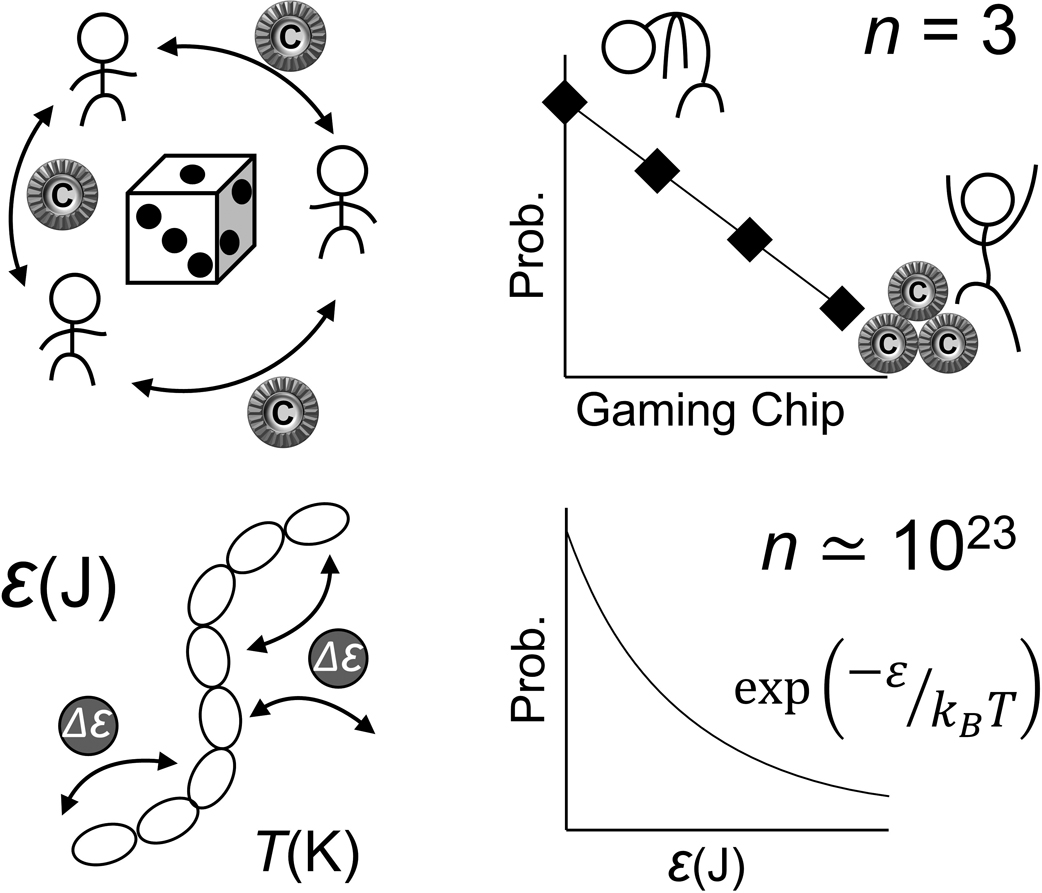2021 Volume 18 Issue Supplemental Pages S001-S002
2021 Volume 18 Issue Supplemental Pages S001-S002
Which is fairer, random distribution or exchange? Let us play a simple dice and chip game to answer this question. First, roll one die to distribute 30 chips among six friends. Then, roll two dice to randomly exchange the chips [1]. Which part of the game widens the gap between the rich and the poor? After playing these games by hand you will develop a better understanding of the physics of molecular ensembles (statistical mechanics) and a greater appreciation of the latest research on molecular machines and single-molecule analysis (research in single protein level dynamics to understand the principles governing life). These are the main concepts of this Special Issue.

Fumio Oosawa (10th Dec, 1922–4th March, 2019) was one of the founders of the Biophysical Society of Japan and a pioneer of single-molecule studies. Many of his former students and scientific colleagues are leading biophysicists in the world today. Although standard textbook approaches to the teaching of statistical mechanics often begin with the consideration of a very large number of particles (~1023), Oosawa showed that the theory can be intuitively developed by application to a small number of particles through simple dice and chip games. These games are closely related to his attempt to develop and apply statistical mechanics to small systems with relatively few degrees of freedom (such as a motor protein). Therefore, the concept of this book is very helpful for those attempting to understand the latest single-molecule studies. We have translated this textbook to introduce some of Oosawa’s novel concepts in physics to the world.
The original Japanese textbook [2] was based on a series of lectures at a summer school run by the Society of Young Scientists in Biophysics 1996 (21st–23rd July, 1996, Hachioji, Tokyo, Japan). Prof. Oosawa was very eager to publish an English version of the original Japanese textbook. In response to his requests, the English translation project was started at a mourning symposium, held in his honor, at the 57th Annual Meeting of The Biophysical Society of Japan (16th–18th September, 2019, Miyazaki, Japan). The simulations supporting this project constructed by Shoichi Toyabe (Tohoku University) can be accessed from the website of The Society of Young Scientists in Biophysics [3]. With these efforts, the English version of Oosawa’s statistical mechanics has commenced serial publication.
In converting the text to English we have done our very best to keep much of the kindness and humor that shone through when reading Oosawa’s book in the original Japanese. Especially, the text contains Oosawa’s personal impressions and private comments on specific phenomena and research fields. We have decided to translate with minimal changes and corrections to express our respect for Oosawa. We hope that readers will be able to comprehend and feel Oosawa’s unique perspective in confronting natural phenomena. We acknowledge that it is difficult to completely reflect the original intentions of Oosawa in this translation and the editorial translation team offers its apologies in advance for any imprecise wording present within this English version.
The COVID-19 pandemic restricts the face-to-face social communication in the world recently. Thus, playing dice and chip games with your friends is difficult at present, but you can also play alone as Oosawa did. It was Prof. Oosawa’s strong feeling that playing dice and chip games by hand was both a powerful and fun way to develop an intuitive understanding of the complex field of statistical mechanics. It has also proved to be extremely useful for furthering our understanding in research on molecular machines and single-molecule analysis.
In closing this prologue, we would like to pray for Fumio Oosawa and to thank his bereaved family for agreeing to publish this English version in this journal.
Masayo Inoue, Meiji University; Noritaka Masaki, National Institute of Genetics; Kiyoshi Ohnuma, Nagaoka University of Technology; Masako Ohtaki; and Taro Toyota, The University of Tokyo; Author names are listed in alphabetical order (with all authors having contributed equally)
The translation team would thank Yoshie Harada (Osaka University; President, Biophysical Society of Japan) and Haruki Nakamura (Osaka University; Editor-in-Chief, Biophysics and Physicobiology) for their support of the project. We also thank Damien Hall (Kanazawa University) for additional proofreading of the manuscript.